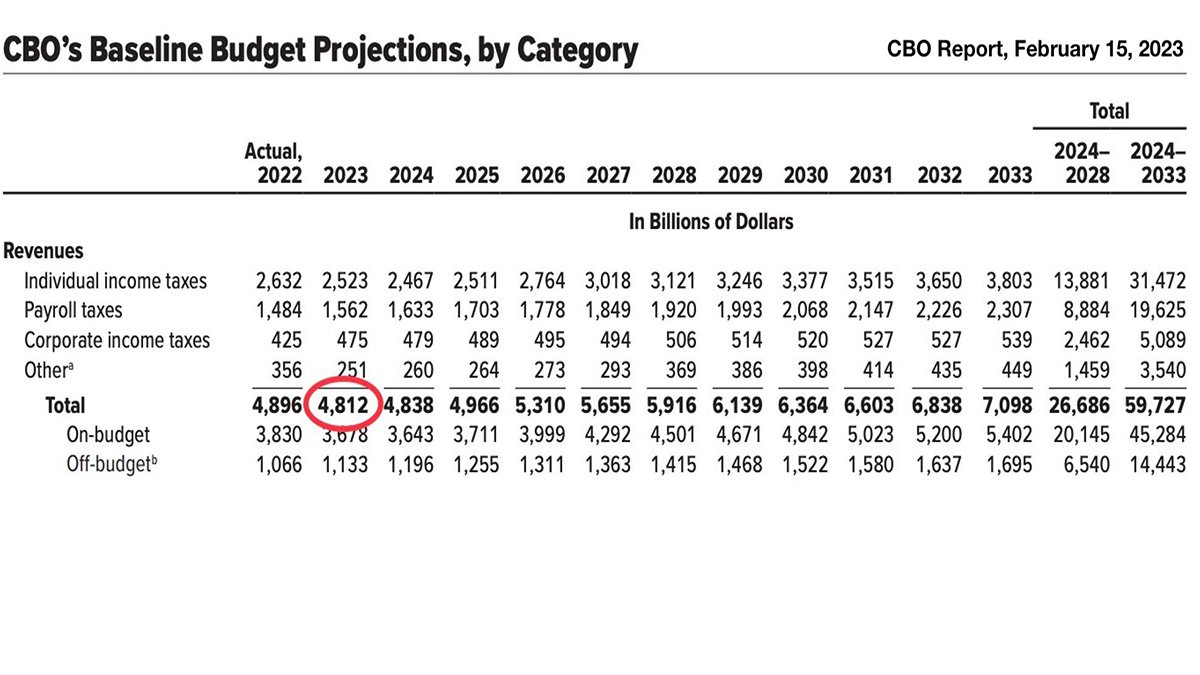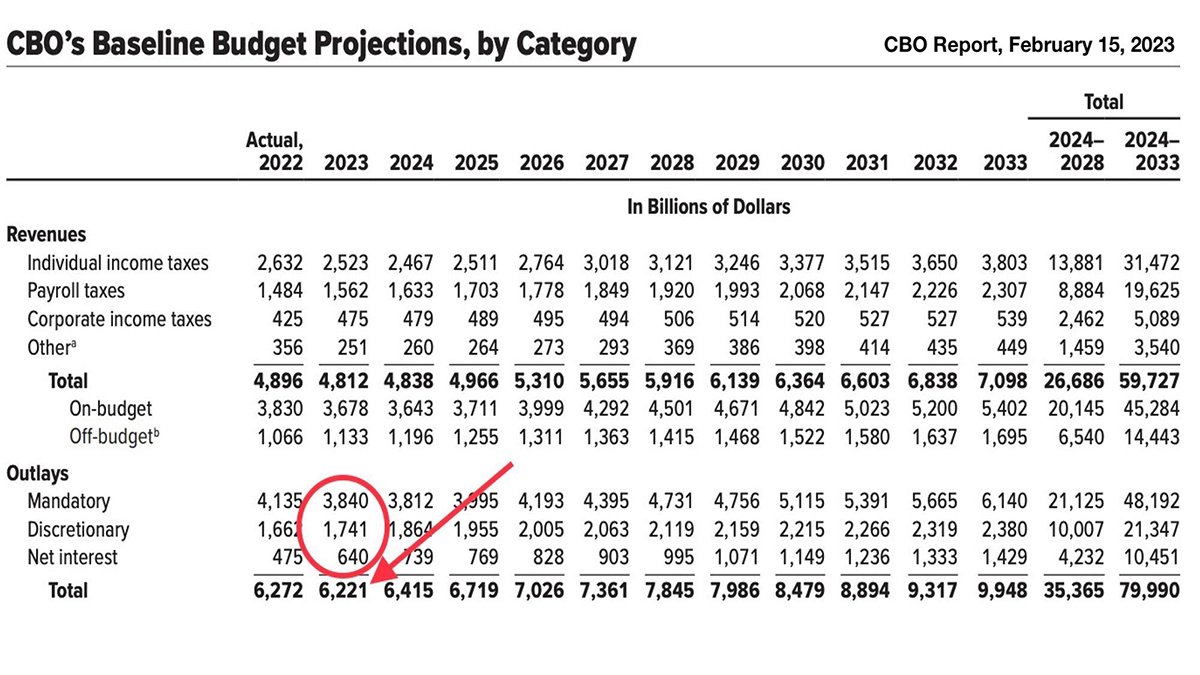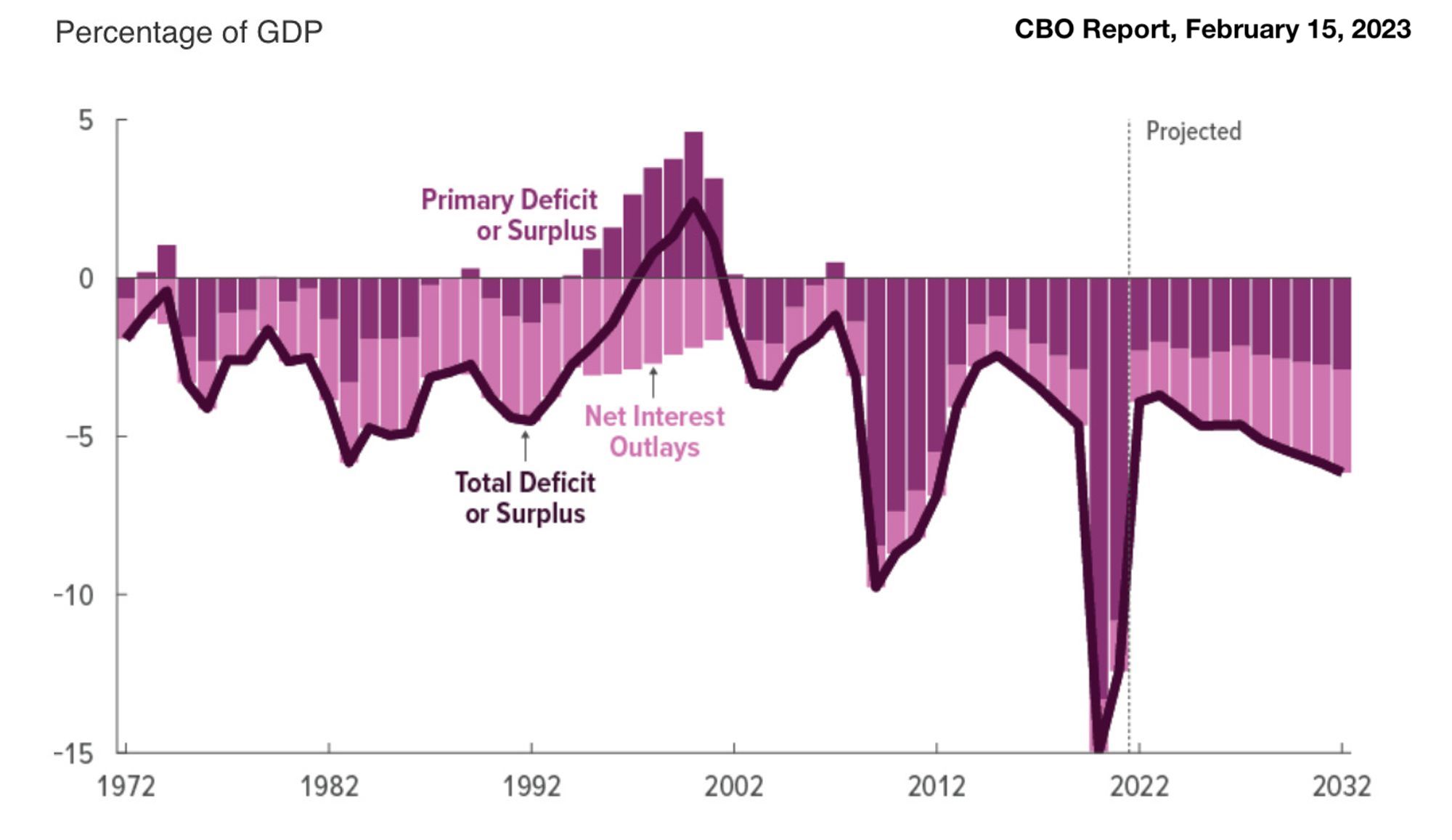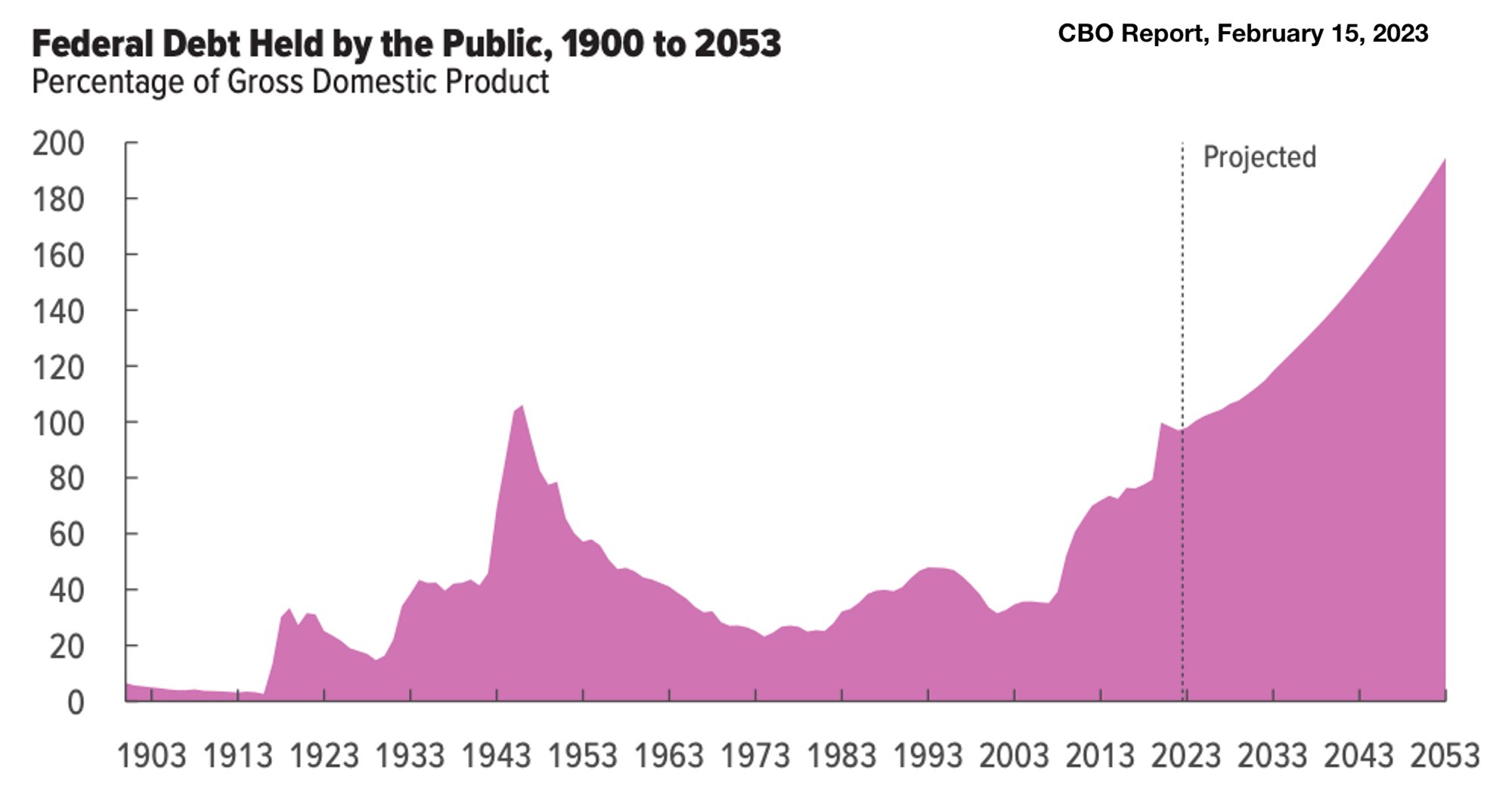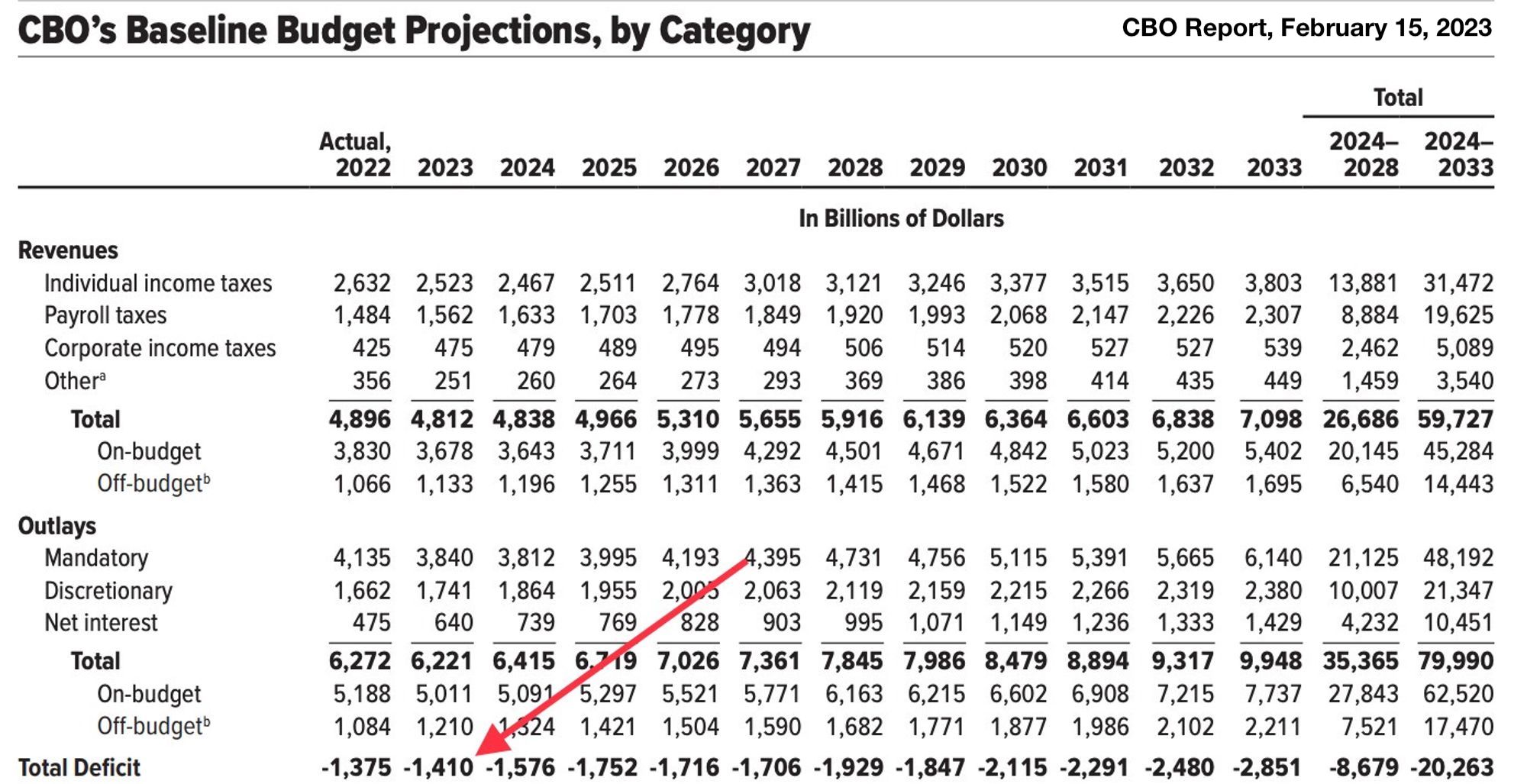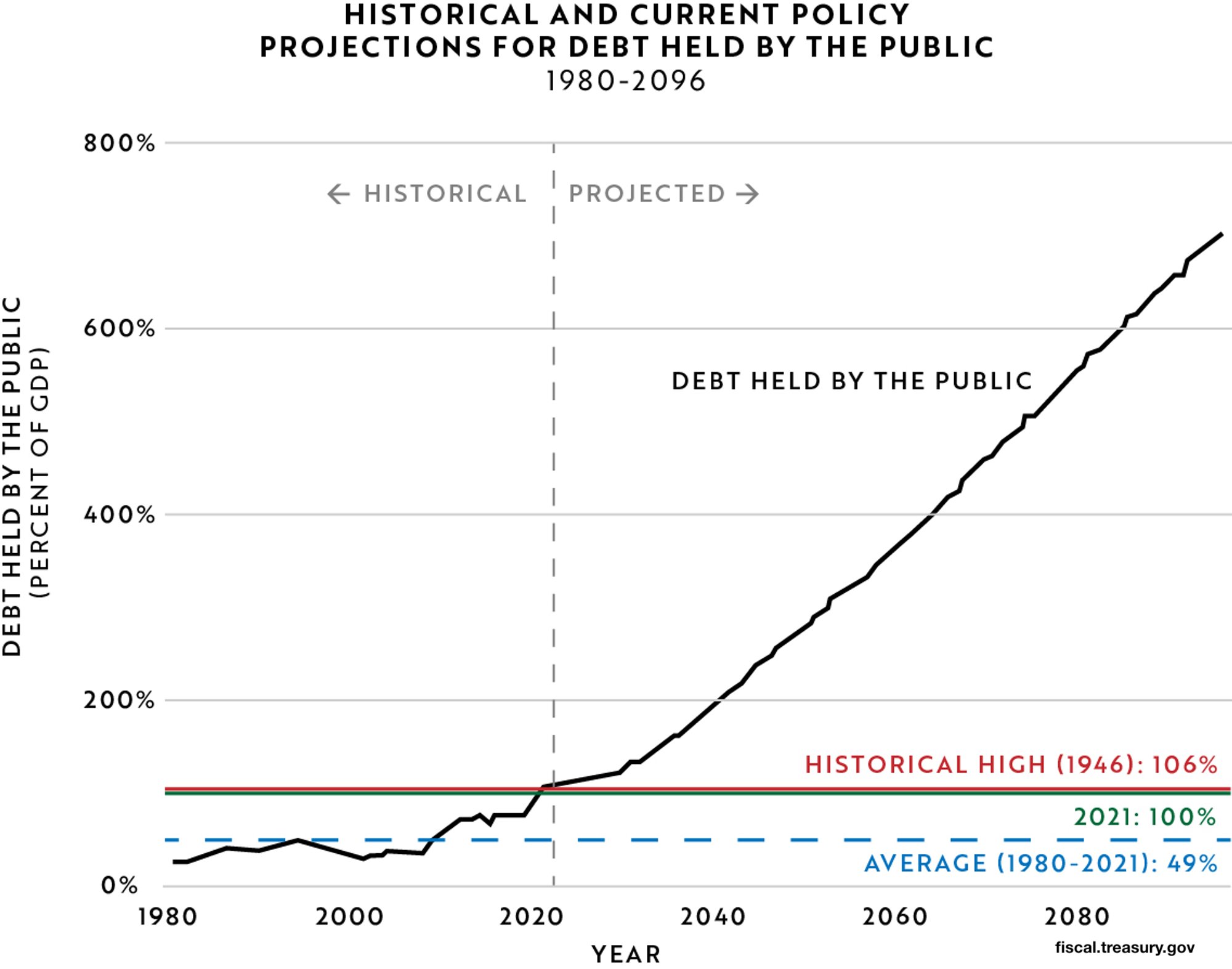Thread by James Lavish
- Tweet
- Mar 15, 2023
- #Banking #Finance #FinancialCrisis
Thread
With the 'sudden' onset of bank insolvency and credit risk, it seems a good time to peek at the US Treasury’s *own* financial position.
Take its debt temperature, so to speak. This is a long but really important one, so saddle up and settle in.
It's time for debt 🧵👇
Take its debt temperature, so to speak. This is a long but really important one, so saddle up and settle in.
It's time for debt 🧵👇
🥸 What’s the CBO report?
First off, CBO stands for Congressional Budget Office, the federal agency that semi-regularly provides budget information and economic forecasts to Congress
And the CBO recently published its federal budget projections for the next 10 years.
First off, CBO stands for Congressional Budget Office, the federal agency that semi-regularly provides budget information and economic forecasts to Congress
And the CBO recently published its federal budget projections for the next 10 years.
A few key points from the report summarizes what the CBO expects:
• GDP is projected to stop growing early this year and start growing again by second half of 2023
• The CBO expects inflation to remain above 2% through 2024 and return to 2% by 2026
• GDP is projected to stop growing early this year and start growing again by second half of 2023
• The CBO expects inflation to remain above 2% through 2024 and return to 2% by 2026
also,
• Interest rates on Treasury securities are projected to rise further in early 2023 and then gradually fall later this year
• The unemployment rate is projected to increase to 5.1 percent at the end of 2023 and decline to 4.5 percent by the end of 2027
• Interest rates on Treasury securities are projected to rise further in early 2023 and then gradually fall later this year
• The unemployment rate is projected to increase to 5.1 percent at the end of 2023 and decline to 4.5 percent by the end of 2027
Interesting predictions and perhaps a bit rosy for my tastes, considering a few key indicators and the likelihood of the Fed holding rates too high for too long—even in the face of the latest debt crisis
But let's go with it and unpack the report, shall we?
But let's go with it and unpack the report, shall we?
🤑 Expected Receipts
If you’ve been following me or are an 🧠Informationist reader, you likely already know that the federal budget hinges on a few main items
We classify these items as either mandatory expenses or revenues
If you’ve been following me or are an 🧠Informationist reader, you likely already know that the federal budget hinges on a few main items
We classify these items as either mandatory expenses or revenues
Mandatory expenses are those that are either signed into legislation and therefore mandatory or contractual, such as:
• Entitlements: Social Security, Medicare, or Medicaid,
• Entitlements: Social Security, Medicare, or Medicaid,
or,
• Defense: long-term spending contracts, ones that must be paid
• And Interest Expense (this is the interest the Treasury has to pay on all that debt they’re piling up)
• Defense: long-term spending contracts, ones that must be paid
• And Interest Expense (this is the interest the Treasury has to pay on all that debt they’re piling up)
As for the revenues (they aren’t actual revenues, per se, as the gov't is not in the business of making money, but rather they're in the business of taking money, i.e., collecting tax revenues from all of us)
So, let’s focus on those collections, first.
So, let’s focus on those collections, first.
Taking a peek at the budget predictions, we see that CBO expects the US Treasury to take in about $4.89T in 2023
This is then projected to increase by over $2T to $7T by 2033, 10 years from now
This is then projected to increase by over $2T to $7T by 2033, 10 years from now
That’s an increase of about 47%. Not too bad.
GDP rises, taxes rise. All good right?
Well, let’s not get too excited, because this is just half the picture. And, a subtle little detail here is that the CBO assumes no recessions
Ever.
GDP rises, taxes rise. All good right?
Well, let’s not get too excited, because this is just half the picture. And, a subtle little detail here is that the CBO assumes no recessions
Ever.
This is a bit of a red flag for me. I mean, we know we have economic cycles, pretty much induced and exacerbated by central banks themselves
And as it stands today, IMO we have an extremely high likelihood of a coming recession this year and perhaps into next.
And as it stands today, IMO we have an extremely high likelihood of a coming recession this year and perhaps into next.
There are many reasons for this, and one strong indicator is the 10yr and 2yr UST yield curve having been severely inverted recently.
If you’re wondering what this means, or need a refresher, I wrote a whole article recently explaining it:
jameslavish.substack.com/p/yield-curve-inversions-and-signals?utm_source=substack&utm_campaign=post_e...
If you’re wondering what this means, or need a refresher, I wrote a whole article recently explaining it:
jameslavish.substack.com/p/yield-curve-inversions-and-signals?utm_source=substack&utm_campaign=post_e...
Additionally, it's unclear just how tight the lending market is about to get with banks all trying to shore up their financial positions and weather this credit storm we are (not so suddenly) in
So, even without a banking meltdown, lending will likely tighten here.
So, even without a banking meltdown, lending will likely tighten here.
Tighter lending leads to lower productivity, which means lower revenues for companies and individuals
Lower revenue leads to lower income. Lower income means?
Exactly. Lower taxes.
Lower revenue leads to lower income. Lower income means?
Exactly. Lower taxes.
So, the Treasury’s revenues—collections—seem a bit fluffy this year and going forward.
OK, then how do the rest of the projections look?
Let’s see…
OK, then how do the rest of the projections look?
Let’s see…
🤨 Expected Outlays
As we said above, the expected outlays—expenses—are mainly entitlements, defense spending, and my personal favorite as of late: interest payments.
How’s it looking, from the CBO vantage?
As we said above, the expected outlays—expenses—are mainly entitlements, defense spending, and my personal favorite as of late: interest payments.
How’s it looking, from the CBO vantage?
It appears expenses are coming in a bit heavy
I mean, the expected 2023 Mandatory expenses are $3.8T, up quite a bit from what the CBO projected to be $3.6T just last May
But this increase is largely due to the 8.7% COLA (Cost of Living Adjustment) in entitlements going forward
I mean, the expected 2023 Mandatory expenses are $3.8T, up quite a bit from what the CBO projected to be $3.6T just last May
But this increase is largely due to the 8.7% COLA (Cost of Living Adjustment) in entitlements going forward
Net Interest is also up from the predicted $442B, and is now $640B in 2023
As many of you already know, some of this was expected, as interest the Treasury has to pay on newly issued debt is far higher than rates they were paying on old debt that is now maturing.
As many of you already know, some of this was expected, as interest the Treasury has to pay on newly issued debt is far higher than rates they were paying on old debt that is now maturing.
Looking forward 10 years, it appears the CBO expects that expenses are likely going to grow about 60% to about $10T by 2023
Hold up, you say
That’s a lot more than the expected rise in ‘revenues’ of 47% in the next 10 years
Yeah, about that…
Hold up, you say
That’s a lot more than the expected rise in ‘revenues’ of 47% in the next 10 years
Yeah, about that…
Here’s the thing.
The CBO knows it, publishing a few charts with its budgets, like this one, showing the growing deficit that the Treasury faces.
oops?
The CBO knows it, publishing a few charts with its budgets, like this one, showing the growing deficit that the Treasury faces.
oops?
😱 The (optimistic yet horrifying) Result
Putting it all together, we can get the full picture of what the CBO predicts over the next decade. And it looks like this:
Putting it all together, we can get the full picture of what the CBO predicts over the next decade. And it looks like this:
Now you see why the charts above look so ugly. The CBO expects us to lose more and more money annually, in perpetuity
Something I’ve talked about extensively, it's called a debt spiral
And I wrote all about it here: jameslavish.substack.com/p/-whats-a-debt-spiral-and-is-the-us?utm_source=substack&utm_campaign=post_e...
Something I’ve talked about extensively, it's called a debt spiral
And I wrote all about it here: jameslavish.substack.com/p/-whats-a-debt-spiral-and-is-the-us?utm_source=substack&utm_campaign=post_e...
But wait. It gets better
The US Treasury released its *own* report recently, titled an 'Executive Summary and 2021 Financial Report of U.S. Government'
The subtitle of the report?
'An Unsustainable Fiscal Path'
The US Treasury released its *own* report recently, titled an 'Executive Summary and 2021 Financial Report of U.S. Government'
The subtitle of the report?
'An Unsustainable Fiscal Path'
That’s right. That's in the title
But wait. The Treasury not only outright admitted to the massive fiscal problem the US now faces, but they also added a single graphic to the report
One that seemed to be placed in there to absolutely *hammer* the 'unsustainable' point home.
But wait. The Treasury not only outright admitted to the massive fiscal problem the US now faces, but they also added a single graphic to the report
One that seemed to be placed in there to absolutely *hammer* the 'unsustainable' point home.
And hammer it does:
*Holy Mother of God*😱
They actually published this. For the whole world to see. (h/t to @LynAldenContact for seeing this first and alerting me to it)
*Holy Mother of God*😱
They actually published this. For the whole world to see. (h/t to @LynAldenContact for seeing this first and alerting me to it)
Wait. I know what you’re thinking
This was a 2021 report published last year. Hasn't the picture gotten worse since?
Well, yes. The Treasury recently announced that it expects to borrow a whopping $932B in the *first quarter of 2023*
Why?
This was a 2021 report published last year. Hasn't the picture gotten worse since?
Well, yes. The Treasury recently announced that it expects to borrow a whopping $932B in the *first quarter of 2023*
Why?
In their own words:
'The borrowing estimate is $353 billion higher than announced in October 2022, primarily due to the lower beginning-of-quarter cash balance ($253 billion), and projections of lower receipts and higher outlays ($93 billion).'
'The borrowing estimate is $353 billion higher than announced in October 2022, primarily due to the lower beginning-of-quarter cash balance ($253 billion), and projections of lower receipts and higher outlays ($93 billion).'
There you go, folks, lower tax receipts and higher spending, confirmed by a recent report showing the biggest monthly decline in US tax receipts on record in January.
At this rate, we will be running not a $1.4T deficit, but more likely a $2T+ deficit in 2023.
At this rate, we will be running not a $1.4T deficit, but more likely a $2T+ deficit in 2023.
So, the Treasury's debt temperature this year and for the foreseeable future is hot
Like inferno hot
The kind that leads to an eventual meltdown.
Like inferno hot
The kind that leads to an eventual meltdown.
The debt spiral is on, we are in it, and the Treasury and Fed have little choice but to eventually swoop in and print more, inflate more, monetize more
All paths lead to inflation
Why?
All paths lead to inflation
Why?
Because at this rate, the US will be left with only two choices: print money and buy its own debt, or default
And I mean a real default—not a timing technicality from a debt ceiling—one where the US haircuts bond owners and either walks the debt or pays them less than they owe.
And I mean a real default—not a timing technicality from a debt ceiling—one where the US haircuts bond owners and either walks the debt or pays them less than they owe.
Which, of course, they will never willingly do
They’ll just print it all away instead. For as long as they possibly can.
They’ll just print it all away instead. For as long as they possibly can.
🧠 How to protect yourself
So, what can you do about it? How can you protect yourself from all this printing, all this inflation?
First let’s be clear, every person has their own distinct investment situation. No one strategy fits everyone.
So, what can you do about it? How can you protect yourself from all this printing, all this inflation?
First let’s be clear, every person has their own distinct investment situation. No one strategy fits everyone.
It all depends on your liquidity, your earnings, your age, your tolerance for risk, etc.
As for me, I’m lower risk and not a kid. I have plenty of expenses and needs for cash. I also have a long term outlook for my portfolio.
As for me, I’m lower risk and not a kid. I have plenty of expenses and needs for cash. I also have a long term outlook for my portfolio.
Today, I hold a large percentage of my portfolio in cash, as I believe there is a high probability that we enter a recession and the market sells off.
I'm waiting for public market opportunities to present themselves
I'm also holding a larger than typical percentage of my portfolio in precious metals, mostly gold and silver
All of these holdings are either secured in a vault, or for my IRA I hold ETFs with audited vaults.
I'm also holding a larger than typical percentage of my portfolio in precious metals, mostly gold and silver
All of these holdings are either secured in a vault, or for my IRA I hold ETFs with audited vaults.
I'm also holding and buying #Bitcoin opportunistically in here
I expect more volatility and entry points for all hard monies throughout these next few months.
I expect more volatility and entry points for all hard monies throughout these next few months.
I hope this helps and gives you ideas of what to talk about with your own investment advisor.
As we used to say in hockey when the game began to get particularly chippy or violent, "keep your head on a swivel out there."
As we used to say in hockey when the game began to get particularly chippy or violent, "keep your head on a swivel out there."
This thread is a summary of a recent Informationist Newsletter. If you enjoyed it, make sure to:
1. Follow @jameslavish to see more investment related content
2. Subscribe to The Informationist to learn one simplified concept weekly: jameslavish.substack.com/
1. Follow @jameslavish to see more investment related content
2. Subscribe to The Informationist to learn one simplified concept weekly: jameslavish.substack.com/
This is so important for everyone to understand, I've removed the paywall from the full article for anyone to see and share. jameslavish.substack.com/p/the-latest-cbo-report-taking-the
